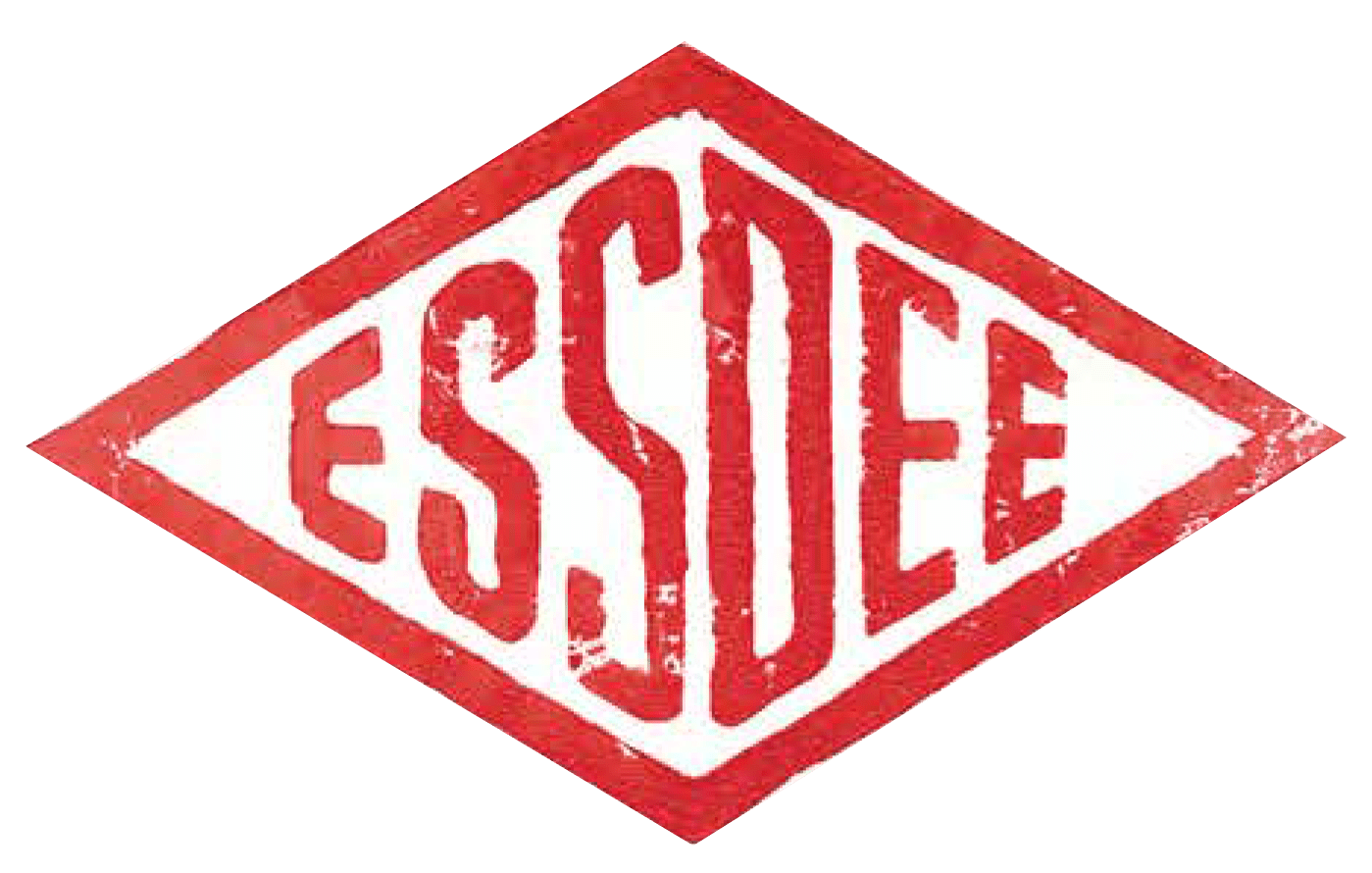frequently asked questions
categories
Choose a category listed below and find the answer you are looking for.
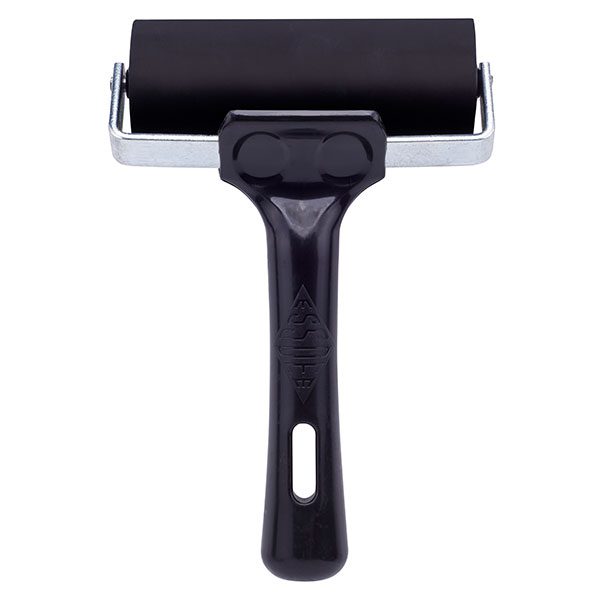
Rollers
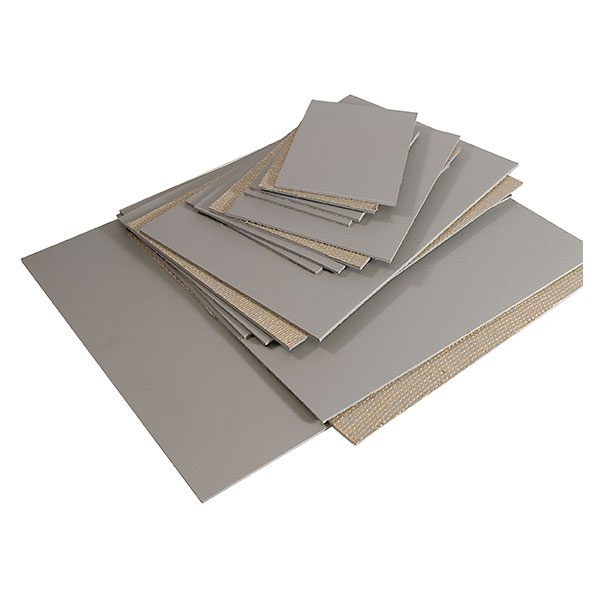
Carving Materials
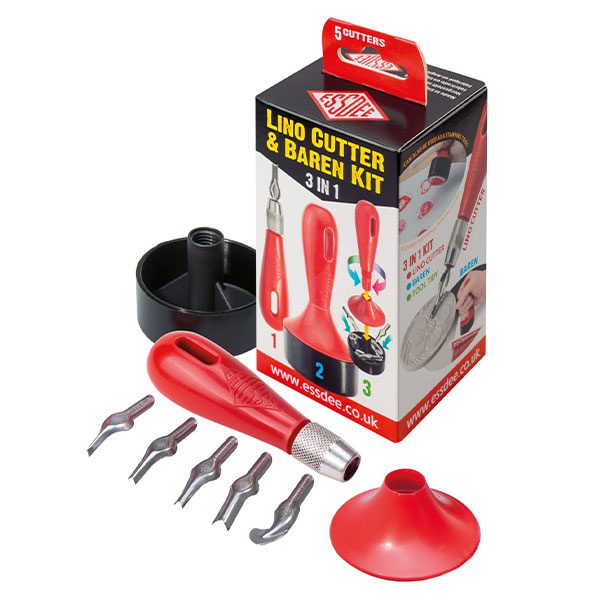
Cutting Tools
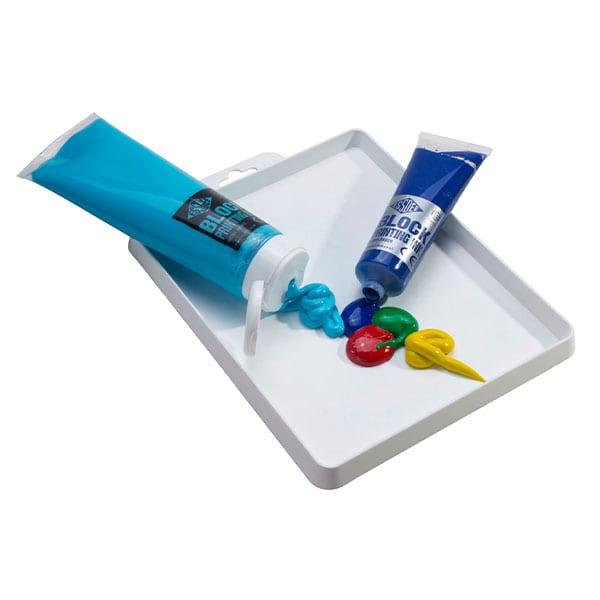
Block Printing Inks
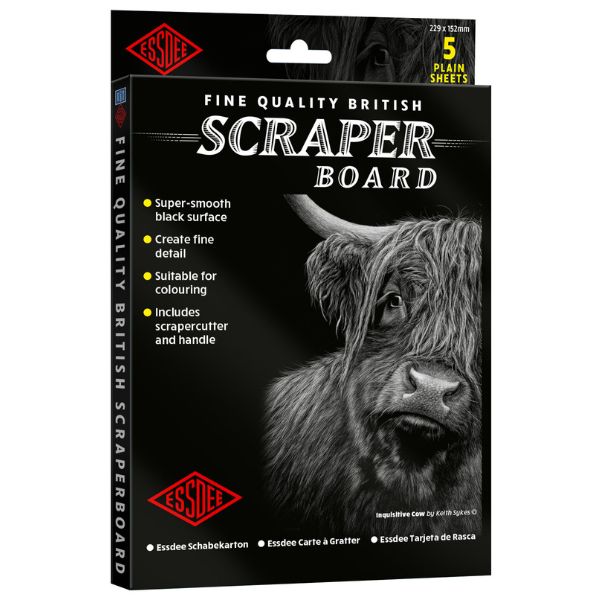
Scraper board
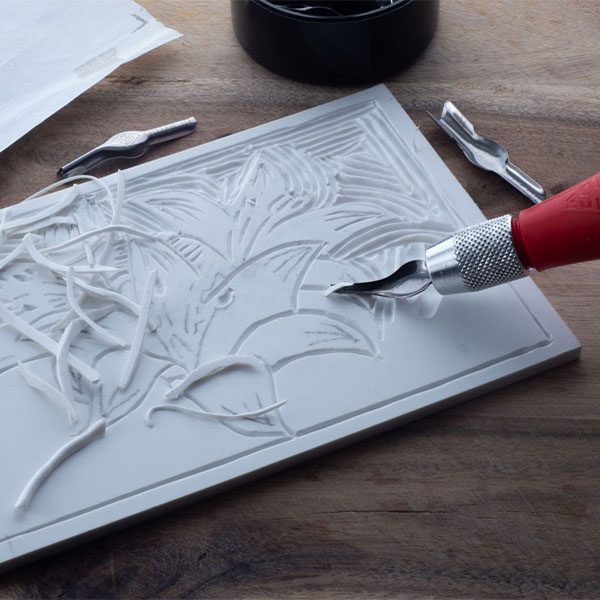
Environment, allergies & Other
Rollers
What are your rollers made from?
Our lino printing rollers are made from EPDM (ethylene propylene diene monomer) which is a type of synthetic rubber. The hardness of the EDPM is measured on the ‘shore’ scale. The lower the shore value, the softer the rubber.
Our rollers have an aluminium core, self-lubricating nylon bearings, a continuous steel shaft and rigid steel brackets. The handle is made from polypropylene. It features a useful hanging slot and, when turned over, the handle becomes a stand so that the inked rubber does not touch the surface that you are working on. Our 250mm and 300mm sizes feature double handles.
Several of our rollers are also ground to enhance their specific performance. Our Professional roller is cylindrically ground to produce a concentric, micro textured surface to hold wet ink tightly, increasing its capacity.
Our Fabric roller is cylindrically ground to open the closed cell structure and produce small pockets or wells that can hold watery or slippery coatings very effectively.
Are your rollers suitable for using with geli plates?
How should I store my rollers?
We recommend hanging your rollers by the hole in the handle or putting it on a flat surface, resting the roller on its back so that the rolling surface is not touching anything. This will help to keep your roller free from permanent indentation.
My roller isn’t spinning/rolling very well – it keeps getting stuck, can you help?
How do I clean my roller?
All Essdee inks are water-based and can be easily cleaned using warm water. You may also wish to use a small amount of washing up detergent.
Oil-based inks are harder to clean up. You should NOT use white spirit, turpentine or anything described as a solvent to clean our rollers. Using solvents on any rubber or rubber like material will cause the material to breakdown.
Our step-by step advice for cleaning your Essdee roller is:
1. Roll out as much of the residual ink on to old newspaper as possible.
2. Work liquid detergent into the pores and small areas of remaining ink.
3. Wash out under a running tap.
4. Tap out and water that may have entered the bearings at the ends of the roller.
5. Hang by the hole in the handle or on its back, so that the rolling surface is not touching anything. This will help to keep your roller free from permanent indentation.
What types of rollers do you make?
| Name | Handle Colour | Shore/ Material | Properties | Sizes |
|---|---|---|---|---|
| Standard Ink Roller | Red Purple (exclusive to our Essentials Kit) | 70 Shore Hard | Strong, sturdy and versatile. Can be used with water and oil-based inks. Strong enough for industrial purposes like the application of window films and vehicle graphics. | 50mm 75mm 100mm 150mm 200mm 250mm 300mm |
| Professional Roller | Black | 60 Shore Medium-hard | Heavyweight professional roller. Machine-ground roller surface for perfect concentricity. Larger circumference. Holds a greater quantity of ink. Enhanced pick up and transfer – especially useful for larger printing blocks. | 50mm 75mm 100mm 150mm 200mm 250mm 300mm |
| Soft Rubber Roller | Blue | 40 Shore Soft | More forgiving on uneven surfaces. Excellent ink coverage with little effort. Excellent pick up and transfer of ink. | 50mm 75mm 100mm 150mm 200mm 250mm 300mm |
| Fabric Roller | Blue | EDPM with air (ground) | Specially designed for printing on textiles and fabric. Designed to pick up and transfer water-based inks like fabric ink and screen-printing ink, which would be too slippery for a normal roller. | 75mm 100mm |
| Sponge Roller | Blue | Sponge | Ideal for applying paint or ink to stencils or 3D surfaces. Great for the application of glues and adhesives to board and paper. Washable. Interchangeable roller – replace roller by removing rubber washers form the ends of the shaft. | |
| Aluminium Craft Roller | White | Hard Polished Aluminium | Designed for rolling out a variety of hobby and craft materials such as silicone rubber, air hardening clays and plasticine. Strong and reliable, designed for high levels of applied pressure. | 50mm 75mm 100mm 150mm |
| Wax Roller | Orange | 25 Shore Very Soft EDPM sponge rubber (with a solid skin not ground) | A versatile tool which can be used for painting with cold wax medium, as well as water-based media and printmaking. Enables paint and ink to be laid onto an uneven surface with ease as it can push into textured areas. Especially useful for cold wax painting, where you can build up layers, create textures and blend colours on the surface. | 75mm 100mm 200mm |
Carving Materials
Can I Laser cut Softcut or Lino?
My lino is sometimes hard to carve, can I make it softer?
If you are working in a cooler environment, you may wish to consider warming your lino slightly so that it is easier to carve. We’ve come across several ingenious ways to do this, including putting it on a radiator or using a hair dryer, although we particularly like the technique of sitting on it whilst you have a cup of tea! Beware though that heating and cooling lino too vigorously can actually cure the material and make it harder.
Do you have any tips for storing lino?
| Product | Colour | Properties | Sizes |
|---|---|---|---|
| Lino | Grey | Traditional hessian-backed linoleum. Made using natural materials such as linseed oil and wood flour. Can be used with water and oil-based inks. Prints well onto a wide range of paper and board. Ideal for use in a printing press. Can crumble/degrade in time. Biodegradable. Some sizes available mounted onto 18mm fibreboard. | 75x75mm 101x152mm 152x203mm 203x305mm 305x406mm 305x305mm 450x450mm 915x915mm 915x1830mm 915x5000mm A6 A5 A4 A3 A2 |
| SoftCut | Cream | Suitable for younger and less experienced artists. Holds a fine line and gives a consistent, sharp print. Suitable for use in a printing press with light pressure too much pressure will distort the print). Can draw on the surface with a soft pencil. Will not crumble or degrade. Carve on the smooth side. Not as easy to ‘flick’ out the material at the end of a cut, but can be sliced with a No.5 cutter to achieve a sharp/abrupt end to the cut. | 75x75mm 105x100mm 150x105mm 210x150mm 300x210mm 420x300mm |
| MasterCut | White | Soft and flexible rubber like material. Extremely easy to carve. Easy to cut out shapes with a craft knife so great for stamp making. Ideal for fabric printing. It’s flexible nature helps it print well by hand onto all kinds of paper and fabric. Softer and thicker than SoftCut. More delicate than Lino. | 100x100mm 100x150mm 150x200mm 200x300mm Circular stamps |
| PrintFoam | White | Foam blocks. Fun and safe introduction to block printing for younger users. Easily indented. Gives a crisp print. Easily washed and re-inked to make more prints. Can be cut to different sizes, shapes and stamps with a craft knife. Can be used for model making. | A5 A4 |
Cutting Tools
What are your cutters made from?
Essdee lino cutters are manufactured from high-carbon steel. Our cutters are sharp, durable and precision ground to an optimum angle to provide effortless lino cutting. The handles are ergonomically designed and made from durable polypropylene with aluminium ferrules.
What types of cutting tools do you make?
We manufacture 11 different styles of lino cutter. They are labelled No 1 to No 10, and a Style A cutter. The cutters to go from smaller to larger. They are a variety of V shaped gouges and U shaped gauges of various widths and sizes, including those designed to make fine lines, wide shallow cuts and deep cuts.
The No1 cutter is a narrow V shaped cutter, which works very well in SoftCut and produces sharp, narrow cuts, which are great for fine detail. The No2 cutter is the most universal cutter, and is a wider V shape and can be used to achieve many different cuts.
The No5 cutter is different, it is a straight blads which can be used in Lino to create cuts or slits, or in SoftCut to describe the edge of a line, which is useful if you are carving up to a defined line and what a sharp and abrupt end to your cuts.
We also make a safety cutter (style A) which is designed to protect hands and allow safe cutting. Details of the different cutter styles and their uses can be found HERE on page 9 of the catalogue.
Our lino cutters are available in packs of 5 or 12 as well as assorted cutters in packs of 10 or 25. Our handles are also available in a box of 12.
We also manufacture scraper tools designed for use with scraperboard. They are made from high carbon steel and are hardened and tempered to maximum limits for long life. They are jig-ground to provide the optimum scraping edge. We make 5 different styles of cutters which are designed to make fine lines, medium lines, dots and circles, clearing large areas and cross-hatching. They can be purchased in an assorted set or in boxes of 12 cutters of the same style. Details of the different cutter styles and their uses can be found HERE on page 9 of the catalogue.
Can I sharpen my lino carving tools?
How do I change the cutters in my lino handle?
Do you have any tips for how I can store my lino cutters?
Our innovative Lino Cutter and Baren set includes the usual lino cutters and handle, but it can also be converted into a baren. The baren base doubles up as a storage unit to keep your cutters safe after use.
If you don’t have an Essdee baren, we would advise keeping your lino cutters in a container that will keep them dry and which is sturdy enough to keep the cutters safe. We find that a small plastic takeaway carton is ideal!
Have you got any tips on how to keep safe when carving my design?
Lino cutters are sharp, so you should always carve away from your hand/fingers. You can move the block around using your non-carving hand rather than constantly turning the cutter.
You should use a shallow angle between the cutter and the block, don’t dig too deep. You should also not use too much force when carving. Carving in this way will help to minimise the changes of slippage and the cutter making contact with your hand/fingers.
You could also use a Safety Hand Guard to protect your hand. The guard is held at the corner or top of the carving material, close to the area being cut. Any slippage is caught in the walls of the guard, protecting your hands for harm.
You may also want to consider using a bench hook. These keep your work steady. Simply place the bench hook on the edge of your desk or work surface for tidy, safe working.
Block Printing Ink
What are your block printing inks?
Essdee block printing inks are high quality water-based inks made with specialist ingredients for smooth flow, excellent coverage and vibrant prints. The non-permanent ink has enhanced tack and excellent transfer properties, with a perfectly balanced drying time, making them easy to use and clean up. They also feature a flow control cap. Our inks are non-toxic, are not tested on animals and are vegan friendly.
They are designed for use with Essdee Linoleum, SoftCut, MasterCut and PrintFoam, but can also be used with many other printmaking materials and techniques. Our block printing inks can be used on all grades of paper and card, and can be intermixed to create a full palette of colours, tints, tones and shades. You can find out more about how to mix our inks in this blog by Dave Hall.
What types of inks do you make?
We offer a wide range of inks. In our block printing range we have 18 standard colours, 6 fluorescent colours, 6 pearlescent colours and 3 metallic colours. All of our block printing inks are available in 300ml, and many are also available in 100ml tubes. We sell multipacks of inks.
We also make a range of fabric blocking printing inks, which are specifically designed for use on fabric. These are also water-based, but once heat-set they adhere to the fabric. Please see the next question for more details about our fabric block printing ink.
Can I use Essdee block printing inks on fabric?
We would not advise doing this as the ink is water-based and not permanent. The ink is likely to smudge on the fabric, and if it comes into contact with water, will wash out. We make a range of fabric block printing inks, which once dried and then heat set become bonded to the fabric. The ink is available in individual 150ml pots and in a multipack of 5 colours.
Our fabric block printing ink should be used with a fabric roller to ensure optimum pick up and transfer of the ink.
We sell a fabric lino printing kit which contains everything you need to get printing onto fabric. You can find out more about how to use our fabric block printing ink here. You can also find out more in our fabric printing blog.
How long does your Essdee block printing ink take to dry?
Typically, ink will dry faster if your prints are in a warm, dry environment, and will take longer if they are in a cooler or humid environment.
As an example, if your prints are in a cold studio in a dark corner, they could take weeks to dry. If they are hanging on a string drying rack elevated in a warm dry room, they could take approximately 2 hours to dry. Drying time also depends on the thickness of the ink on your print, the thicker the application the longer it will take to dry.
To speed up the drying time, we advise applying the ink in thin layers, and you could consider using an absorbent, matte paper.
How do I clean up my printing equipment after using Essdee inks?
All Essdee inks are water-based so our rollers and ink trays can be easily cleaned using warm water. You may also wish to use a small amount of washing up detergent.
Our step-by step advice for cleaning your Essdee roller is:
1. Roll out as much of the residual ink on to old newspaper as possible.
2. Work liquid detergent into the pores and small areas of remaining ink.
3. Wash out under a running tap.
4. Tap out and water that may have entered the bearings at the ends of the roller.
5. Hang by the hole in the handle or on its back, so that the rolling surface is not touching anything. This will help to keep your roller free from permanent indentation.
Our ink trays can be cleaned by wiping away any residual ink with old newspaper and then wash it down under a running tap, using some liquid detergent if you wish.
Oil-based inks are harder to clean up. You should NOT use white spirit, turpentine or anything described as a solvent to clean our rollers. Using solvents on any rubber or rubber like material will cause the material to breakdown.
Why is there a safety label on the white block printing ink informing me that hazardous droplets may be formed when sprayed, and not to breathe spray or mist?
Our white block printing ink contains titanium dioxide, which is a white pigment with excellent light scattering properties. It is used in over 90% of white paint and ink products. It is also found in products such as plastics, textiles, ceramics, cosmetics, food and pharmaceuticals. It gives a whiteness, brightness and durability of colour that cannot be achieved with other raw materials.
The European Commission has given a classification to titanium dioxide when the product is used in a powder form only, so those using liquid ink will not be affected. However, when the Commission considered the applications that may form respirable droplets, it introduced the requirement to label liquid mixtures with warning statements. We are therefore required to include a warning on our packaging (EUH211).
The powder form of titanium dioxide presents no risk. It is not volatile and consumers using printing inks cannot be exposed to lung overload of the dust particles of titanium dioxide.
There is also no harm when liquid paints containing titanium dioxide are sprayed, although users are advised to wear appropriate personal protective equipment, including masks and goggles. However, due to the viscosity of our block printing ink, and the purpose for which it is intended to used, we would not expect users to spray the ink.
Does your block printing ink stain?
Yes, block printing ink can stain! So always wear protective clothing and take care to protect furniture.
Scraperboard
Is your scraperboard of archival quality?
Does the Essdee White Scraperboard show black once scraped
Other
What are you doing to be more sustainable?
Our lino is made from natural ingredients, including linseed oil and wood flour, and is biodegradable. Our inks are water-based and free of toxins, our products are all latex free, and our lino printing products are vegan friendly.
We have joined programmes to recycle our waste Lino and SoftCut back into the manufacturing process, and we have replaced plastic packaging with recyclable cardboard and biodegradable wrapping.
Our new product range, linoprinting onto fabric, provides a great opportunity for customers to reuse existing fabric (such as old t-shirts or cushion covers) to create a bespoke and unique piece of clothing or item of soft furnishing.
We use as many local suppliers as possible in order to reduce the carbon footprint of our supply chain, and we continue to make eco-friendly changes where we can, to join the efforts in slowing global warming.
We are delighted that our efforts have been recognised by Craft Business by being shortlisted in the 2021 Best Sustainable Craft Company Award.
Where are your products made?
We are a UK manufacturer and all of the products that we sell, with the exception of Lino, are made in the UK. The majority of our products are made at our HQ in Kidderminster, Worcestershire.
Where can I buy your products?
Our products are available all around the world in a large range of physical and on-line shops. To find a retailer you can use the search facility on the ‘Buy Our Products’ webpage.
Where can I find lino printing inspiration?
There is a huge Lino printing world available online. Many artists display their prints on platforms such as Instagram and Pinterest, and we share work by both professional and hobbyist printers on our Instagram, Facebook, LinkedIn, Pinterest and Youtube. You can also join various printmaking groups, there are some great ones on Facebook. You can also check out our blog pages, which contain lots of tips, ‘how to guides’ and interviews with printmakers.
